12 Fun Soccer Games for Kids (2024 Update)
As well as teaching kids the basics, soccer training sessions should also be exciting, engaging and encouraging, in particular with younger ones who are just starting out.
That's why it's a good idea to throw in lots of fun soccer games for kids which will get them looking forward to each and every session, all while learning new skills and making new friends.
At that early stage it is important to keep things simple and straightforward as they are still learning the rules and how to actually play the game.
It’s best to work on one or two things at a time rather than overcomplicate and confuse them.
To help your young one or the team you coach develop new skills while having a great time, here are ten fun soccer games for kids which are perfect for 5 to 8 year olds.
10 Tips for Youth Soccer Coaches
Before working our way through all the fun games you can run, it’s worth just quickly going over some tips that will help make every training session go smoothly.
As 5 to 8 year olds are a very specific age group, you will want to tailor your practice sessions to their capabilities and not make things too complicated.
As well as honing their touch and technique, sessions should challenge them, teach them how to be a team player, help them make friends, and above all have fun and enjoy playing soccer.
Here are some things to bear in mind when coaching young kids:
1. Be prepared and plan the session and games in advance.
2. Be warm, welcoming and friendly and show genuine happiness at seeing them at practice.
3. Take an interest in them, ask questions and involve all of the players on the team.
4. Encourage them and use positive language and praise at all times.
5. Keep explanations and exercises simple and straightforward and show them examples.
6. Keep them engaged and excited by varying up the games and working on different skills.
7. Mix up the teams so no one dominates, everyone gets to play together and experience winning.
8. Be a positive role model and project positivity with your body language.
9. Ensure that things are fair and everyone follows the rules.
10. Make sure to use the correct size ball for the age group.
11. Have fun with your team and enjoy each and every training session together!
Now that we've looked at some things to take into account when coaching kids, let's move onto the fun games you can run to keep them engaged and interested at all times!
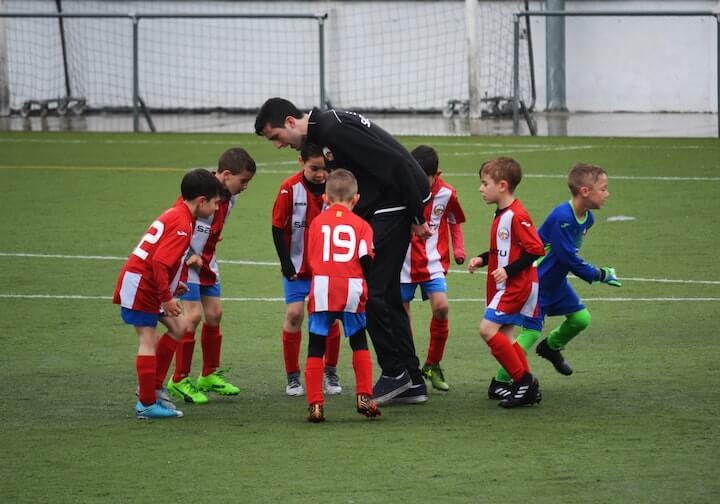
12 Soccer Games for Kids
Besides helping kids with their control and coordination, these fun games also work on everything from their touch and technique to their passing and shooting.
While all of them can be run by coaches in their training sessions, many of them can also be done at home, in the garden, or on any available patch of space.
All you need is a ball and some cones and then you are all set to help your team or young one develop new soccer skills while having a great time!
1. Tag
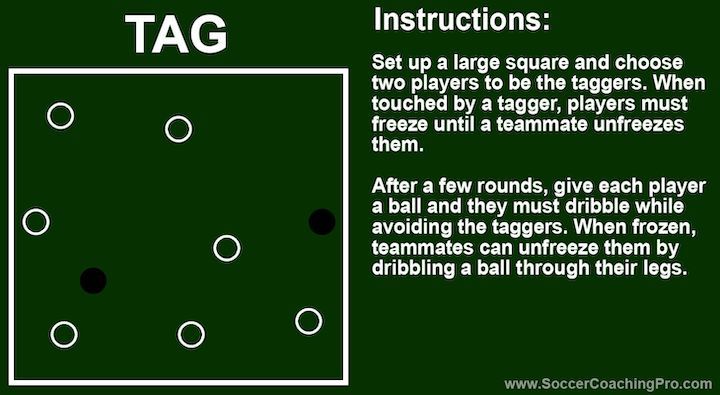
A great warm up exercise that is sure to get your team pumped up and raring to go is tag or 'it' as it is also known.
Very easy to run, this game helps players with their fitness and teamwork skills as well as their close ball control and dribbling if you also use a ball.
To set up the drill all you need to do is make a large square and have two players in bibs be 'it'. When you blow the whistle they then attempt to tag the other players.
If touched, the players must then freeze and stand still in the same spot. They can only be unfrozen if one of their teammates manages to touch them.
Another alternative is to have them stand with their legs apart and have the players crawl between them to unfreeze them.
The game ends once all the players have been frozen by the two players who are 'it' with the rest of them trying to prolong it for as long as possible.
Once the players have played a few rounds, give each of the team a ball and have them try to avoid and dribble away from the two who are 'it'.
When they are frozen their teammates can unfreeze them by passing their ball between their legs.
2. Simon Says
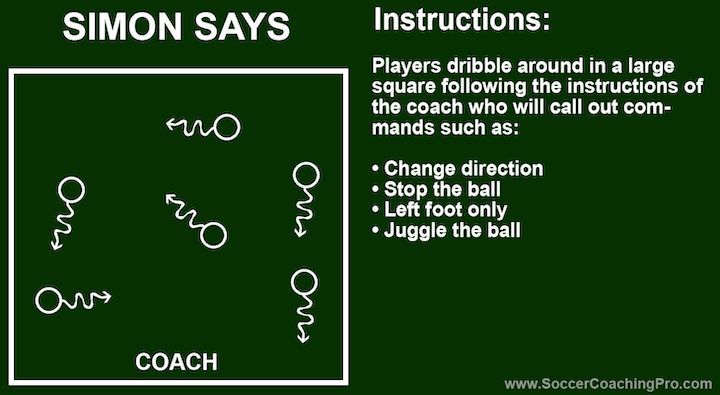
Another one of the great soccer games for kids is Simon Says, which sees the players listen out for and follow instructions.
In a large box, the players dribble about with a ball at their feet until a coach or a player who is Simon shouts out a command such as change direction, stop the ball, only use your left foot, etc.
As the players never know what instruction is coming next, they need to focus and listen out for what they say.
Other commands could get the kids jumping or clapping, juggling the ball, or even kicking it as far away as they can!
3. Musical Balls
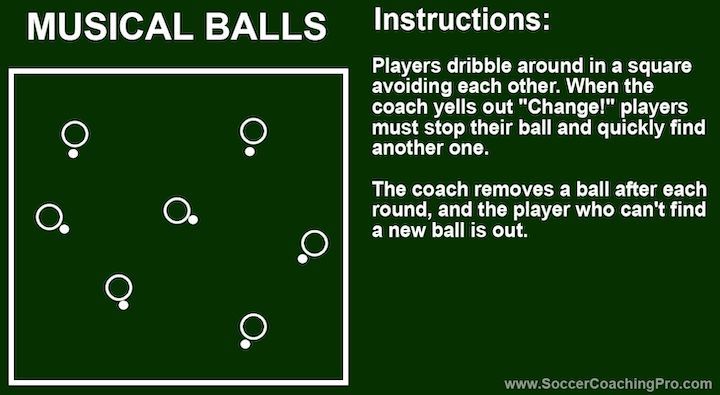
In a similar vein to Simons Says is Musical Balls which helps young kids to improve their control, coordination, and dribbling skills.
To play the game all you need to do is set up a square, give each player a ball and then set them off dribbling within the grid, avoiding each other, and keeping the ball as close to them as possible.
After thirty or so seconds you shout 'Change!' and the players have to stop their ball and quickly find another one to start dribbling with.
Once they’ve got the hang of it, remove a ball after each round.
The player who can't find a ball then stands on the sidelines and cheers the rest of the team on until only one player remains and wins the game.
Parents can also run this drill at home by setting up an area for their kid to dribble in and simply get them to practice controlling, stopping and dribbling the ball.
4. British Bulldog
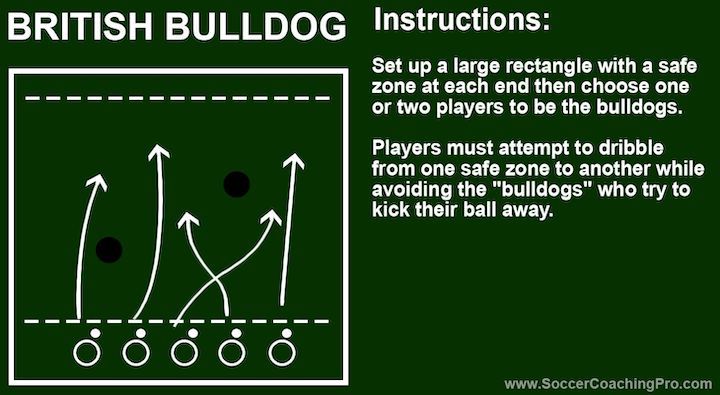
Another great game to help with young players' spatial awareness, dribbling skills, and tackling is British Bulldog.
This classic game sees most of the team line up at one end of a grid and attempt to dribble their way through a 'danger zone' without being tackled or have their ball kicked away by a 'bulldog'.
To set up the drill simply place four cones in a line about ten metres apart with a parallel line about twenty metres away. The first and last boxes of this grid are 'safe zones'.
In the middle or 'danger zone', there are two players or 'bulldogs' whose job it is to stop the rest of the team from getting through safely with their ball.
The players can either use stealth, speed, or their dribbling skills to get past the bulldogs and to the line at the end of the safe zone.
When a player is tackled and loses their ball, they can either become another bulldog or wait on the side on the pitch and cheer on their teammates.
The game ends when only one player remains and they are declared the winner!
To help explain the game to the kids it is a good idea to first play a round of British Bulldog without balls so they can see how it works.
After that you can get the bulldogs either doing a 'bear crawl' or 'crab walk' to give the players more of a chance before letting them run about and tackle normally.
5. Red Light, Green Light
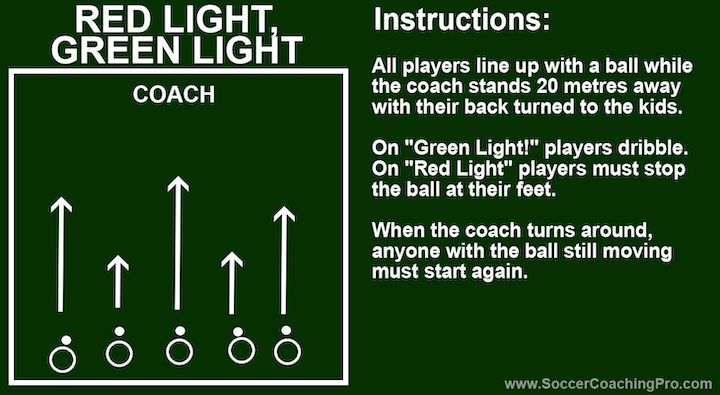
As with British Bulldog, “Red Light, Green Light” also rewards players for their close control and dribbling skills. In addition, it also highlights the importance of reacting quickly and listening out for the coach's command.
With this drill, all the players line up with a ball at their feet with the coach standing around twenty metres away with their back turned towards the kids.
When the coach shouts out 'Green light!' the kids then proceed to dribble towards the coach, ready to stop the ball at a moment's notice.
When the coach shouts 'Red light!' the players have to immediately freeze where they are with the ball lying stationary and stopped at their feet.
After waiting a moment, the coach turns around to see if anyone is moving. If they are, they are then sent back to the start line to start from the beginning.
In this way they learn to control the ball, react quickly, and listen to commands.
6. Fill the Bucket
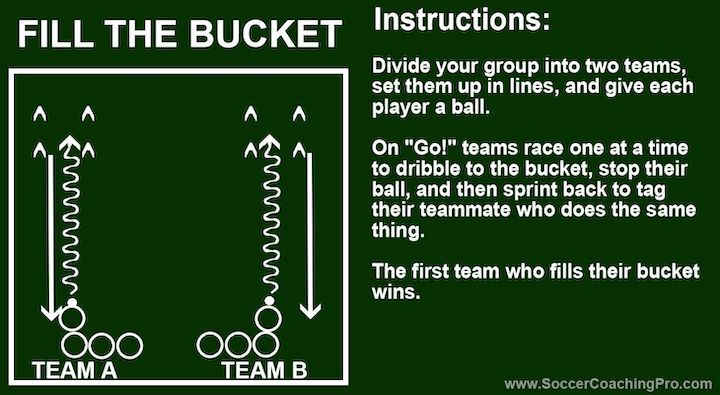
Another game you can run that will excite and exhilarate the kids is the fun and frenetic Fill the Bucket.
This exercise sees two teams race against each other, working on their close control, dribbling skills and acceleration at the same time.
All you have to do is divide each team in two, give each player a ball and then set them up in two lines facing each other, around twenty metres apart. In the middle of the two lines make a smallish box or 'bucket' with four cones.
When you shout 'Go!' the first player from each team runs with the ball to the box.
They then stop the ball and continue sprinting to their teammates on the opposite side.
Once they arrive, their teammate with the ball can do the same thing but in the opposite direction.
Like this, the two teams race until all the balls are in the 'bucket' and all the players are back at the end lines. The team that is fastest wins the race!
After this you can also play 'Empty the Bucket' which instead sees the players race to the box and then either dribble to the opposite side with a ball at their feet or do an accurate pass back to their team mate.
Another alternative is to set up some cones for the players to dribble through on their way to or from the 'bucket'. This makes it even more challenging and competitive!
7. King of the Ring
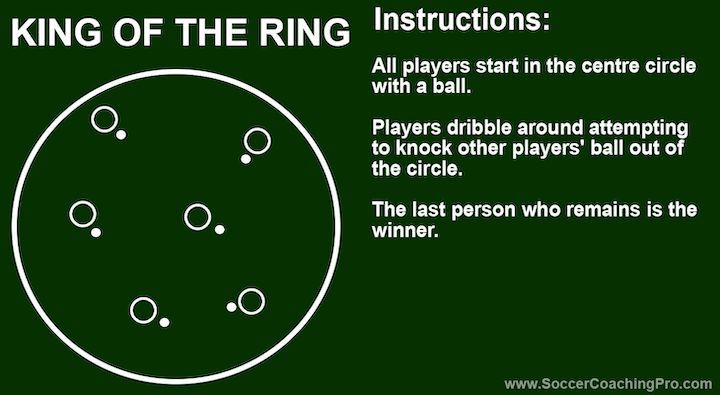
Lots of fun to play, King of the Ring helps improve both players' close control and dribbling skills as well as their spatial awareness, defending, and decision making.
In the centre circle, all of the players dribble about with a ball at their feet, ready to knock another player's ball out of the ring.
As anyone can tackle anyone, players need to protect their ball and watch out for other people while also trying to knock out their opponents' balls.
Once they lose their ball, players collect it and wait on the side of the ring, cheering the others on.
The game ends when only one player remains in the ring with their ball at their feet.
As there are different tactics and approaches involved, players improve their decision making and awareness of what is going on around them.
8. Piggy in the Middle
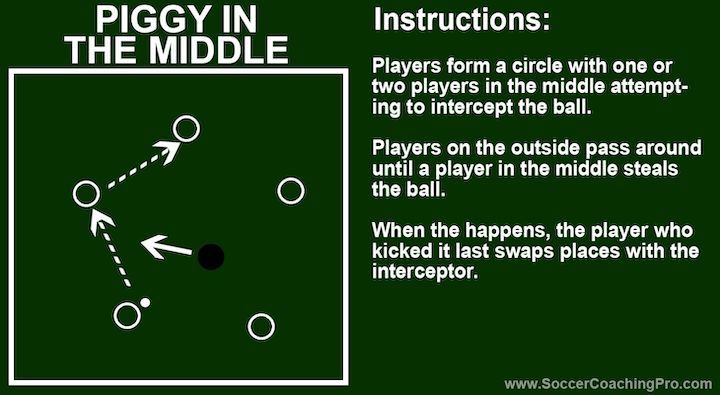
Another one of the classic soccer games for kids that is also fantastic for warm ups and improving your players' passing is Piggy in the Middle.
Very simple to set up and explain, the exercise is sure to excite and enthuse your young ones.
All you have to do is have the players form a circle with one or two players in the middle trying to intercept the ball and win it back.
The other players have to pass the ball around the circle for as long as possible without one of the 'piggies' intercepting it.
When the player in the centre wins the ball back, they then swap with the player who lost it with them then becoming the piggy.
9. Don't Feed the Monkeys!
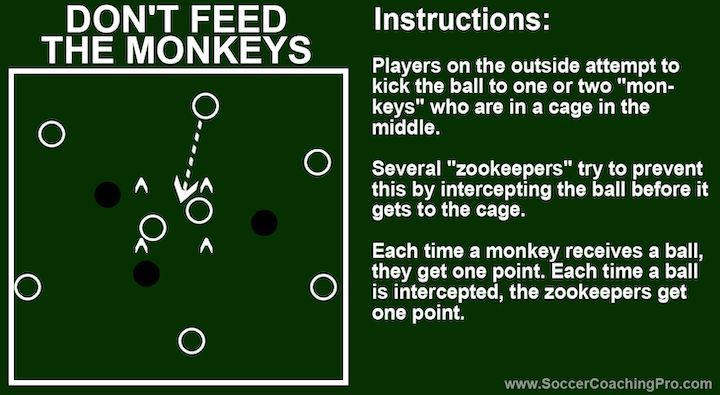
Very fun and funny to play, Don't Feed the Monkeys is certain to leave your players jumping with joy as they attempt to feed monkeys in the zoo!
This drill is great for players' passing as it gets them to focus on the weight and accuracy of their pass as well as receiving and controlling the ball.
To set it up, make a small circle or monkey cage with cones and have two players or monkeys stand within it!
Outside the circle are three or four zookeepers whose job it is to stop the other pesky players from feeding the monkeys.
Surrounding them are six cones with a player and ball at each one. These players then try to feed the monkeys by passing a ball to them past the zoo keepers.
To win a point, the monkey and player must both pass and control the ball without the zoo keeper intercepting it.
This fun game not only helps with the players' passing and controlling but also works on the zookeepers' anticipation skills and defending at the same time.
To make it harder you can always have the players chip the ball in to the monkeys for them to catch, control or header back.
10. Four Goals
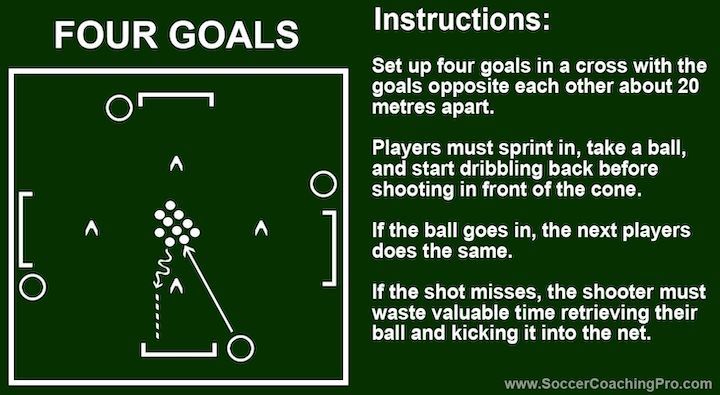
As well as being a race, Four Goals is also a competition to see which team scores the most goals.
With this fun and frenetic game, players learn to dribble at speed, turn quickly, and shoot the ball, developing a love for scoring and competing in the process.
To play, set up four goals using nets or cones in a cross, with the goals lying around twenty metres from the one across from them.
In the middle, place all the balls with two players lining up to the side of each goal.
On your whistle, one of the players from each team sprints to the centre, takes a ball and dribbles it back towards their goal before shooting it into the net.
Once they have scored, their teammate can then do exactly the same thing, working as quickly as possible to score as many as they can.
If a player misses the goal, they then have to waste valuable time retrieving the ball and kicking it into the net before their teammate can set off.
Once there are no balls left, the winner is the team who has scored the most goals.
If you want to focus more on the players shooting then you can always place a cone which they have to shoot from behind.
Another option is to put a line of cones if you instead want to focus on their dribbling abilities.
11. Crossbar Challenge

The exact origins of the crossbar challenge are unknown. Many claim it came from a Nike ad featuring Ronaldinho in 2005 in which the Brazilian maestro played one-two passes to himself using the crossbar.
Others say it came from the popular British TV show, Soccer AM, where each week, a different professional team would take on the challenge. The pros would take turns trying to hit the crossbar from the halfway line.
Now, this might literally be too much of a challenge for your five to eight-year-olds. So, rather than kicking from the halfway line, shorten the distance. Set up a goal and have your players shoot from the penalty spot or the edge of the box.
You can even create a competition. Each player to hit the crossbar goes through to the next round. Repeat the game until there’s one winner.
12. Keepy-Uppy Challenge

Keepy-uppies are usually recommended for individual practice. They can improve ball control significantly. Plus, they get players used to taking touches with different parts of their body, like the knees, chest, shoulders, head, and heels.
For five to eight-year-olds, keepy-uppies can also be a useful way to warm up. Give all of the players a ball each and challenge them to make 10 keepy-uppies in a row, then 15, 20, etc. You can also play team keepy-uppies, where players stand in a circle and try to keep the ball in the air for as long as they can.
However, perhaps the best and most fun keepy-uppy challenge is the one where players head the ball back and forth to one another in a zig-zag shape. The last player in the line then heads the ball into the goal to complete the challenge. You may have seen videos of teams doing this in the locker room and finishing by heading the ball into a trash can.
For a lot of teams, this challenge is rather easy. And, five to eight-year-old players aren't recommended to head the ball.
So, to make this drill a little more fun but challenging, try to complete it in three different ways.
First-time passing (easy).
In the air by any means necessary, using knees, chest, head, etc. (intermediate).
In the air using chest-to-volley (hard).
Divide the team into groups of five and pit the groups against one another in a race to finish all three routines.
Conclusion
To keep young kids excited, enthused, and engaged during training sessions, it's a good idea to pepper your practice with lots of fun games and competitions.
While these help with their control, coordination and dribbling, they also get them to develop their teamwork and communication skills among many others.
Very easy to set up and explain, most of these soccer games for kids can also be run at home with some slight variations.
Besides helping them to master the basics, these small games will get them jumping with joy and having a great time while playing soccer with their friends and teammates.
Further Reading: 123 Soccer Drills for All Ages and Skill Levels (With Images)

